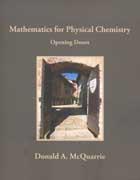Paul Yates reviews this fast-paced text
Mathematics for physical chemistry: opening doors
Donald A. McQuarrie
Sausalito: University Science Books 2008 | Pp348 | £25.99 | ISBN 978 1 89 138956 6
Reviewed by Paul Yates

Books on mathematics which are aimed at chemists vary enormously in their level and scope, usually representing the context in which the author has worked. This volume leaves the reader in no doubt that it is aiming high; one is met with tables of trigonometric identities, power series and definite integrals on the inside cover, and on page one we are told that the first two chapters will review the essential features of a calculus course. The pace from here is correspondingly rapid, with transcendental functions discussed on page two, the sinh and cosh functions defined on page four, and the derivative defined as a limit on page seven. This book would not, therefore, be suitable for the type of introductory course which aims to bring first-year undergraduates with GCSE mathematics grade C up to A-level standard.
The material here has been developed from that in the author's previous books on physical chemistry and quantum mechanics. Consequently, there are chapters on the classical wave equation and the Schrödinger equation, which are more usually found in those specialised texts than in a supporting book on mathematics such as this. However, there is also a useful chapter on Fourier transforms, detailed material on this topic not always being readily available at an appropriate level.
The presentation throughout assumes familiarity with and a lack of fear of mathematical notation. However, good use is made of diagrams and there are several examples within each chapter to illustrate the use of the mathematics. These are generally related to chemistry and fulfil the author's promise to emphasise the application to physical problems.
There are around 25 questions at the end of each of the 23 chapters. Several of these arise from problems in physical chemistry, and the author has explicitly made this link in these cases. This bank of questions will provide a useful resource to anyone who is teaching in this area.
This book would be a useful resource for research students who require a detailed description of the mathematics which underpins physical chemistry, and for anyone teaching mathematics to chemists who needs more detailed resources on a particular topic than are usually available. The book may also have value to the chemistry undergraduate who has a thorough grounding in mathematics before arriving at university.






No comments yet